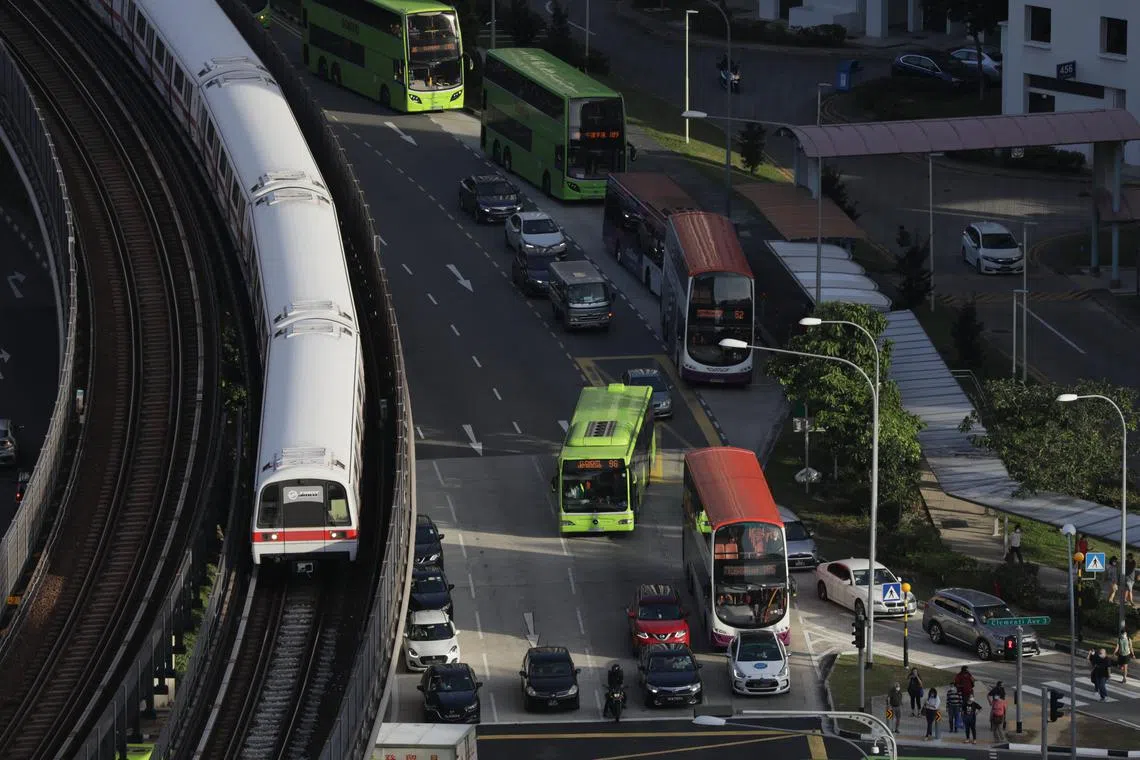Public transport fare formula tweaked to make fare changes more predictable for passengers
Sign up now: Get ST's newsletters delivered to your inbox

The updated formula will reduce volatility resulting from changes to public transport capacity and ridership.
PHOTO: ST FILE
Follow topic:
SINGAPORE - To avoid large swings in fares for passengers who take the bus and train, the way that yearly adjustments to public transport fares are calculated for the next five years has been changed.
Announcing the new fare adjustment formula on Tuesday, the Public Transport Council (PTC) said passenger demand has been taken out of the equation, given the continued uncertainty over the pace and extent of the recovery in public transport ridership post-Covid-19.
Changes to the formula aside, bus and train fares are set to rise in 2023, with the exact amount to be determined during the next fare review in the second half of the year. This is largely due to a 10.6 per cent fare hike that was rolled over from the previous fare review in 2022.
The new fare formula that will be applied from 2023 to 2027 will not use the existing network capacity factor (NCF), which reflects operating costs due to network capacity changes relative to ridership.
Instead, the NCF will be replaced by a fixed “capacity adjustment factor” of 1.1 per cent each year to account for costs related to expanding the public transport system. This fixed component is based on actual and planned capacity improvements to the public transport network here from 2020 to 2026, and largely reflects the improved connectivity and lower journey times arising from the opening of the Thomson-East Coast Line,
The council was tasked in August 2022 with reviewing the fare adjustment formula
Such reviews typically take place every five years. The PTC had formed a 10-member work group to conduct the latest review.
After engaging with commuters in several focus groups and consulting widely with academics, public transport operators and the National Transport Workers’ Union, the PTC said it decided to retain three of the five components that make up the fare formula. These unchanged components reflect year-on-year changes in core inflation, wages and energy prices.
The PTC said these indices continue to reflect closely the operating cost structure of the public transport industry.
While the council had considered at length how to reduce the volatility of the energy price index in the formula, it decided it would be premature to make significant changes, given the uncertainties and exceptional circumstances facing the energy market.
On replacing the NCF with the fixed capacity adjustment factor, the PTC said doing so will reduce volatility resulting from changes to public transport capacity and ridership. The NCF previously ranged from 1.6 per cent to 3.9 per cent before the Covid-19 pandemic struck. But it was excluded from fare adjustment calculations from February 2020, as a sharp drop in ridership
For example, if the NCF had been computed as per normal for the 2021 fare review, it alone would have led to a 60-cent increase in fares, the PTC added.
While public transport ridership has reached 90 per cent of pre-Covid-19 levels in January 2023, the PTC said travel patterns have yet to stabilise because of changes to work practices.
“The final impact on ridership, the typical distance travelled per journey and fare revenue per journey remain unclear,” the PTC said.
“NCF was not designed to track short–term exceptional fluctuations in demand and supply such as during the Covid–19 pandemic,” it added.
Besides doing away with the NCF, the PTC has also changed the way productivity gains made by public transport operators are taken into account in bus and train fares.
The productivity extraction in the 2018 formula was meant to share the operators’ productivity gains with commuters. It was fixed at a 0.1 per cent reduction to fare adjustments from 2018 to 2022.
The 0.1 per cent figure remains unchanged under the new formula till 2027.
However, the component is now a productivity contribution – a target that the operators are expected to hit for the next five years. In other words, operators are expected to make up for the 0.1 per cent reduction in potential fare revenue by improving their cost-efficiency.
The PTC noted that operators here have had negative productivity gains over the past five years due to the shifts in ridership arising from the pandemic and significantly higher costs.
Under the existing formula, the productivity extraction would have been set at zero as a result, it said.
The PTC has also opted to retain a mechanism that allows it to defer fare adjustments to subsequent fare reviews, taking into account social and economic conditions.
This helps to moderate the impact of fare increases on affordability in extenuating circumstances, such as the Covid-19 pandemic, or due to large spikes in energy prices, as was the case in the 2022 fare review exercise, it said. Last year, the PTC granted a fare hike of 2.9 per cent
“The PTC is mindful that deferred fare increases require additional government subsidies to be provided, and hence should be exercised judiciously,” the council said. The Government currently provides more than $2 billion in public transport subsidies a year.
At a press conference on Tuesday, PTC chairman Janet Ang said: “Taken as a whole, the recommendations will allow the fare adjustment formula and mechanism to better respond to the macroeconomics and operating environment, keeping the public transport system financially sustainable.”
In a statement, the Ministry of Transport said it has accepted the PTC’s proposed fare formula and recommendations.
Transport Minister S. Iswaran said the Government will keep fares affordable for all Singaporeans by funding public transport infrastructure and subsidising part of the operating costs.
“We will continue to support vulnerable groups such as senior citizens, lower-wage workers and persons with disabilities with concessionary fares and public transport vouchers,” he added.


